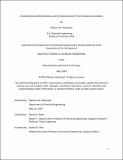Elucidating Dual Methylcellulose-and-Oil-Nanoemulsion Thermoresponsive Gelation
Author(s)
Wojtaszek, Mateusz M.
DownloadThesis PDF (1.332Mb)
Advisor
Doyle, Patrick S.
Terms of use
Metadata
Show full item recordAbstract
The rheological properties of a colloidal gel depend upon the microstructure of the gel and the identity of the load-bearing elements. Here we demonstrate a hybrid hydrogel-colloidal gel system composed of a methylcellulose-stabilized oil nanoemulsion. This system has tunable rheology with two distinct dominant load-bearing components. Oil volume fraction determines which component leads to elasticity in the gel network. At low oil volume fraction, methylcellulose forms a fibrillar gel upon an increase in temperature. As oil volume fraction increases, methylcellulose is sequestered onto the droplet surfaces, decreasing the concentration of methylcellulose available for polymer gel formation and weakening the gel structure. Upon further increase in oil volume fraction, we hypothesize that an oil droplet network becomes the primary load bearing structure, resulting in marked differences in rheology. This represents a unique system in which two gelation regimes with distinct identity and behavior are tuned using only nanoemulsion volume fraction. This behavior is made possible by the unique fact that the component which stabilizes the nanoemulsion, methylcellulose, is also active in the gel itself. Due to the components used, this system has potential uses in applications such as pharmaceuticals and food products.
Date issued
2024-05Department
Massachusetts Institute of Technology. Department of Chemical EngineeringPublisher
Massachusetts Institute of Technology